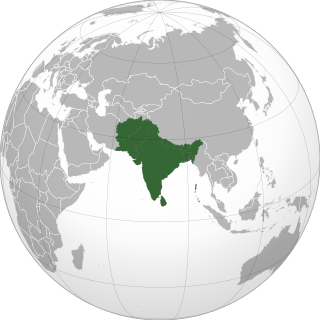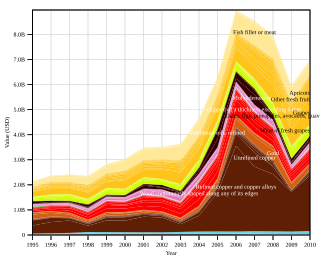
A free trade area is the region encompassing a trade bloc whose member countries have signed a free trade agreement (FTA). Such agreements involve cooperation between at least two countries to reduce trade barriers, import quotas and tariffs, and to increase trade of goods and services with each other. If natural persons are also free to move between the countries, in addition to a free trade agreement, it would also be considered an open border. It can be considered the second stage of economic integration.

A trade agreement is a wide-ranging taxes, tariff and trade treaty that often includes investment guarantees. It exists when two or more countries agree on terms that help them trade with each other. The most common trade agreements are of the preferential and free trade types, which are concluded in order to reduce tariffs, quotas and other trade restrictions on items traded between the signatories.
The Canada–United States Free Trade Agreement (CUSFTA), official name as the Free Trade Agreement between Canada and the United States of America, was a bilateral trade agreement reached by negotiators for Canada and the United States on October 4, 1987, and signed by the leaders of both countries on January 2, 1988. The agreement phased out a wide range of trade restrictions in stages, over a ten-year period, and resulted in a substantial increase in cross-border trade as an improvement to the last replaced trade deal. With the addition of Mexico in 1994, CUSFTA was superseded by the North American Free Trade Agreement (NAFTA).

The Dominican Republic–Central America–United States Free Trade Agreement is a free trade agreement. Originally, the agreement encompassed the United States and the Central American countries of Costa Rica, El Salvador, Guatemala, Honduras, and Nicaragua, and was called CAFTA. In 2004, the Dominican Republic joined the negotiations, and the agreement was renamed CAFTA-DR.
The Australia–United States Free Trade Agreement (AUSFTA) is a preferential trade agreement between Australia and the United States modelled on the North American Free Trade Agreement (NAFTA). The AUSFTA was signed on 18 May 2004 and came into effect on 1 January 2005.

The South Asian Free Trade Area (SAFTA) is a 2004 agreement that created a free-trade area of 1.6 billion people in Afghanistan, Bangladesh, Bhutan, India, the Maldives, Nepal, Pakistan and Sri Lanka with the vision of increasing economic cooperation and integration.
A free trade agreement (FTA) or treaty is an agreement according to international law to form a free-trade area between the cooperating states. There are two types of trade agreements: bilateral and multilateral. Bilateral trade agreements occur when two countries agree to loosen trade restrictions between the two of them, generally to expand business opportunities. Multilateral trade agreements are agreements among three or more countries, and are the most difficult to negotiate and agree.

In international trade, market access refers to a company's ability to enter a foreign market by selling its goods and services in another country. Market access is not the same as free trade, because market access is normally subject to conditions or requirements, whereas under ideal free trade conditions goods and services can circulate across borders without any barriers to trade. Expanding market access is therefore often a more achievable goal of trade negotiations than achieving free trade.

The United States–Bahrain Free Trade Agreement (USBFTA) is a free trade agreement (FTA) between the United States and Bahrain, signed on September 14, 2004. It was ratified by the United States House of Representatives on December 7, 2005, by 327–95, with 10 not voting.
The United States-Colombia Trade Promotion Agreement (CTPA) is a bilateral free trade agreement between the United States and Colombia. Sometimes called the Colombia Free Trade Agreement, it was signed on November 22, 2006, by Deputy U.S. Trade Representative John Veroneau and Colombian Minister of Trade, Industry, and Tourism Jorge Humberto Botero. CTPA is a comprehensive agreement that will eliminate tariffs and other barriers to trade in goods and services between the United States and Colombia, including government procurement, investment, telecommunications, electronics commerce, intellectual property rights, and labor and environmental protection The United States Congress. Colombia's Congress approved the agreement and a protocol of amendment in 2007. Colombia's Constitutional Court completed its review in July 2008, and concluded that the Agreement conforms to Colombia's Constitution. President Obama tasked the Office of the U.S. Trade Representative with seeking a path to address outstanding issues surrounding the Colombia FTA. The United States Congress then took on the agreement and passed it on October 12, 2011. The agreement went into effect on May 15, 2012.

The China–Australia Free Trade Agreement (ChAFTA) is a bilateral free trade agreement (FTA) between the governments of Australia and China. Since negotiations began, 21 negotiating rounds have been completed. The deal was completed on 17 November 2014 and details released two days later, nearly 10 years after its first round of negotiations that began on 23 May 2005 after a joint feasibility study. The free trade agreement was signed between the two countries on 17 June 2015. Following the usual treaty making process the agreement came into force on 20 December 2015, after the Chinese Government completed its domestic legal and legislative processes and the Australian Parliament’s Joint Standing Committee on Treaties and the Senate Foreign Affairs, Defence and Trade References Committee finished a review.
The Comprehensive Economic Partnership for East Asia (CEPEA) is a Japanese led proposal for trade co-operation and free trade agreement among the 16 present member countries of the East Asia Summit. All those movements and efforts were taken over by the following Regional Comprehensive Economic Partnership.
The ASEAN–India Free Trade Area (AIFTA) is a free trade area among the ten member states of the Association of Southeast Asian Nations (ASEAN) and the Republic of India. The initial framework agreement was signed on 8 October 2003 in Bali, Indonesia. and the final agreement was on 13 August 2009. The free trade area came into effect on 1 January 2010. India hosted the latest ASEAN-India Commemorative Summit in New Delhi on 26 January 2018. In the financial year 2017–18, Indo-ASEAN bilateral trade grew by almost 14% to reach US$81.3 billion. India's imports from ASEAN were valued at US$47.13 billion while its exports to ASEAN stood at US$34.2 billion.
The spaghetti bowl effect is the multiplication of free trade agreements (FTAs), supplanting multilateral World Trade Organization negotiations as an alternative path toward globalization. The term was first used by Jagdish Bhagwati in 1995 in the paper: “US Trade policy: The infatuation with free trade agreements”, where he openly criticized FTAs as being paradoxically counter-productive in promoting freer and more opened global trades. According to Bhagwati, too many crisscrossing FTAs would allow countries to adopt discriminatory trade policies and reduce the economic benefits of trade.

The United States-Chile Free Trade Agreement is a free trade agreement (FTA) between the United States and Chile signed on June 6, 2003. The pact came into force on January 1, 2004. On that date, tariffs on 90% of U.S. exports to Chile and 95% of Chilean exports to the United States were eliminated. The agreement also established that Chile and the U.S. will establish duty-free trade in all products within a maximum of 12 years (2016). In 2009, bilateral trade between the United States and Chile reached US$15.4 billion, a 141% increase over bilateral trade levels before the U.S.-Chile FTA took effect. In particular, U.S. exports to Chile in 2009 showed a 248% increase over pre-FTA levels.

The China–Pakistan Free Trade Agreement(CPFTA) is a free trade agreement (FTA) between the People's Republic of China and the Islamic Republic of Pakistan that seeks to increase trade and strengthen the partnership between the two countries.
The China–South Korea Free Trade Agreement is a free trade agreement between China and South Korea signed in 2014 and active since the following year.

The Korea–Australia Free Trade Agreement (KAFTA) is a bilateral free trade agreement designed to diminish barriers to trade and investment between Australia and South Korea, effective from the 12th December 2014. The agreement is designed to improve market access for Australian exporters of goods and services and for investment in South Korea. KAFTA builds upon several decades of bilateral relations, rooted in diplomatic, trade, and security cooperation, which have evolved since 1962. During that year, President Park Chung-Hee introduced a series of five-year economic plans aimed at improving South Korea's industrial development and involvement in the global economy in the aftermath of the Korean War.
India is party to free trade agreements (FTAs) and other trade agreements with many countries and trade blocs, and is negotiating with many others. As of 2022, India has preferential access, economic cooperation and FTA with more than 50 individual countries.
The Agreement on Textiles and Clothing (ATC) succeeded the Multi Fibre Arrangement (MFA), and facilitated the gradual dismantling of quotas for world textile trade that the MFA had put into place. Thus, the Agreement on Textiles and Clothing (ATC) stipulated a systematic and progressive elimination of the Multi Fiber Arrangement (MFA) over a span of ten years. This process culminated on 1 January 2005.









